Great champions have an enormous sense of pride. The people who excel are those who are driven to show the world and prove to themselves just how good they are.
Nancy Lopez, three-time Ladies PGA Champion.
Golf is a solitary sport. To make an impression on a game so imbued with, unfortunately, aspects of the male, chauvinistic, capitalist tendencies, by oneself, is quite the achievement. Without getting into a Marxist-critique of sporting political capital, we can say that Lopez’ eleven-year spell of success redefined the game along feminist lines.
There is a point to this; it isn’t just an anger-take inspired by Rory McIlroy’s poor performance at the British Open. I promise.
In the case of football and the United States Women’s Team, the battle for equality will hopefully soon be won. The equal pay debate is reaching fever pitch and rising interest in the game domestically is only tipping the scales on one side. The USWNT bears the fruits of the excellence of the American domestic game. It’s quality best seen through individuals.
In this tactical analysis, we shall see how the Utah Royals and the Portland Thorns relied on their key players, a few of those who returned the World Cup trophy, to see themselves to a 2-2 draw in the NWSL. Tactical flaws were exploited by individual talent and both sides defined their best attacking plays on similar lines. This was not a game for team spectacles but a welcome return for the USA’s independent heroes.
Lineups and selection
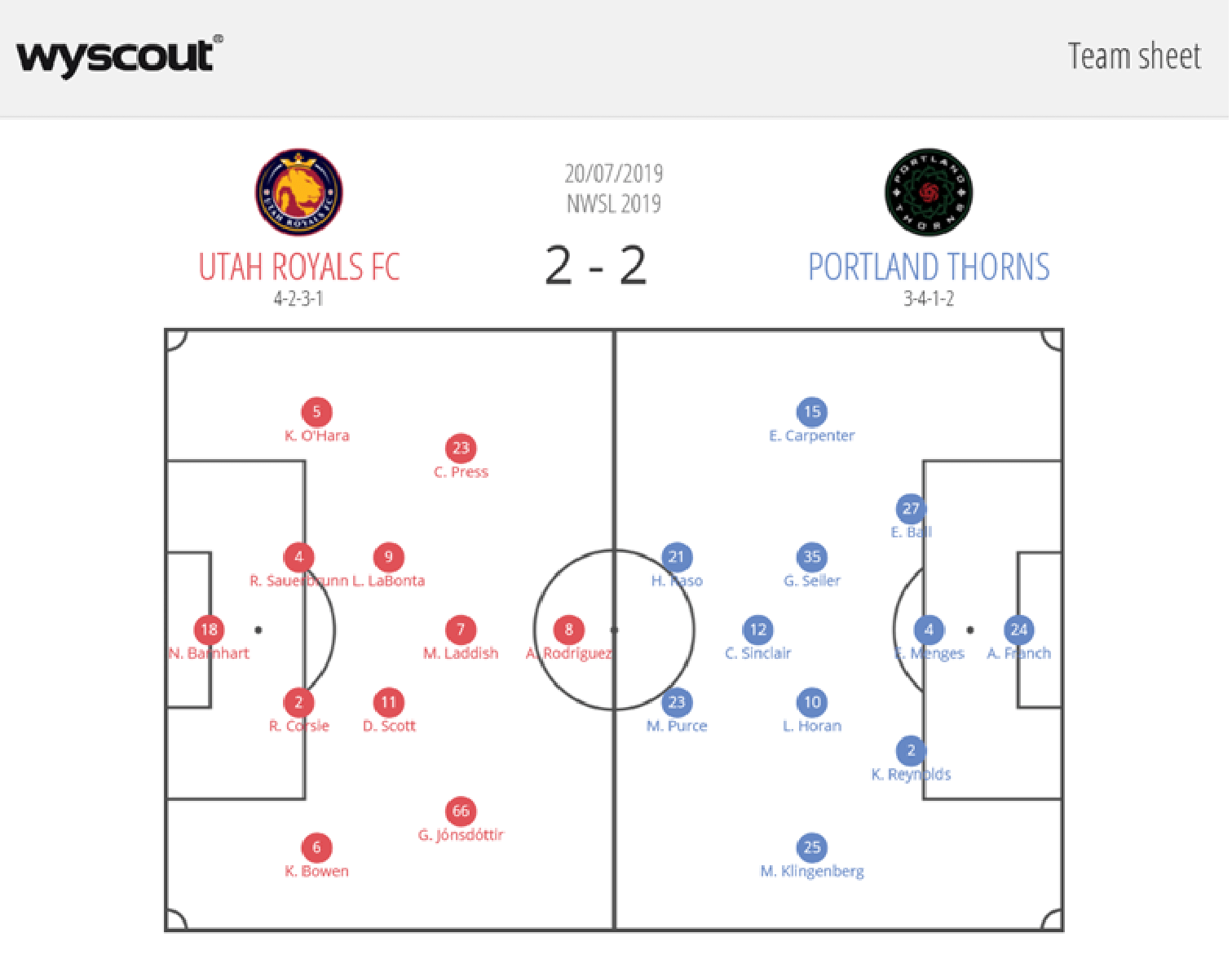
For at least the third match in a row, Mark Parsons went for a three-at-the-back formation. Whilst there is an argument to be made that he has been more consistent with this tactical shape, as we shall discover, Parsons’ side shows a notable distinction between playing three-at-the-back and having three central defenders in a five-player backline.
With regard to personnel changes, unsurprisingly the USWNT returning heroes forced changes to the starting XI. The most notable of these was Lindsey Horan, who replaced Dagný Brynjarsdóttir in the middle of midfield. Yet, we also saw Adrianna Franch, Alyssa Naeher’s national team deputy return to the Thorns goal and Tobin Heath make a cameo appearance from the subs bench.
Laura Harvey had her own crop of World Cup champions to bolster the Utah Royals’ line up. At the back, Kelley O’Hara banished Rebecca Moros from the Royals starting line-up. The former had played in eight consecutive games before O’Hara’s return. It was the return of Team England-slayer, Christine Press, which most excited fans, however.
In terms of tactics, this season Harvey has favoured the four-player defensive line but with alternating options over having either a sole, supported striker or with two forwards and a less congested midfield. Against the Thorns, however, she decided to pack the midfield to force overloads in an often open midfield cavity.
Portland’s narrow defensive backline
Parsons’ favoured 3-4-3 formation was wheeled out again following the pounding it took (whilst still miraculously winning) against a Marta-resurgent Orlando Pride last week. Whilst last week it came under the cosh from the whirling-dervish-Brazilian-infused attacking line-up, once again it proved to be severely limited when faced against similarly spicy opposition.
Whilst Marta was absent for the Pride’s 2-1 victory over Sky Blue, the Utah Royals employed their favourite court jester, the supremely talented World Cup hero, Christine Press, to lead the attack. The below graphics show us how Press’ left side carried the creative burden for the Utah Royals. Indeed, Press made 5 crosses in the game. This is not a huge amount but this crushes her season average of just 2.05.
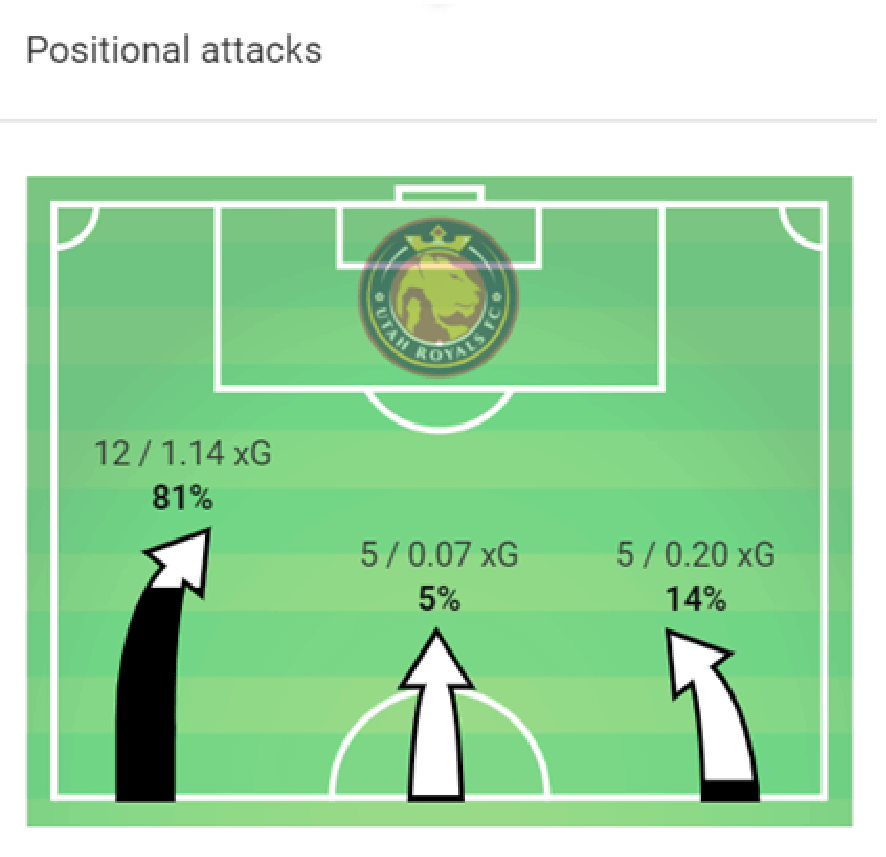
Yet, whilst Press was instrumental in some of her movements, we first have to understand how Portland’s positioning only enabled the Royals to dominate.
Last week, we wrote that the Portland Thorns struggled to cope with Orlando Pride in the second half chiefly because there was a change in the formation. Indeed, in the second half of the game, the Pride retreated into more of an orthodox 4-2-3-1, with Marta sitting in the number 10 role. This enabled her to make penetrative runs through both the deep-lying midfield barrier and the defensive line.
In this game, however, Press was instrumental in exposing the space generated on the left-wing. What was highly apparent as the game drew on was how narrow the Royals made the Thorns’ defence look. Press, Gunnhildur Jónsdóttir and Amy Rodriguez all managed to exploit this narrow three by pushing high on the break and playing on the shoulder of the outside centre backs. The graphics below show us a typical example of the Thorns’ narrow defending enabling space on each side.
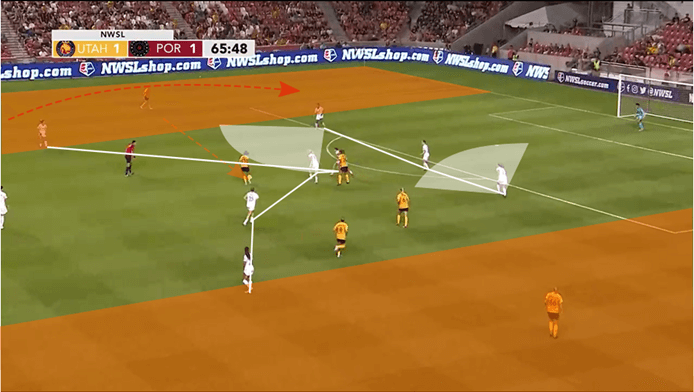
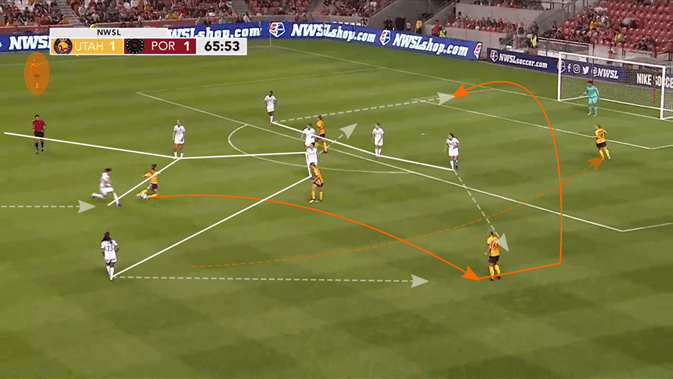
We can see that the Thorns are determined to retain a three-player defensive line, so Klingenberg comes in whilst the central pairing push a little further forward to fill the middle.
Furthermore, this only leads to players watching the ball and an awkward funnel defensive shape that encourages play out wide to the wings. Press is the ball carrier in the example and manipulates this by moving inside to open space for O’Hara down the wing.
The underlying cause of such space, however, must be attributed to the strong impulse Parsons’ side placed on using their wing-backs of Ellie Carpenter and Meghan Klingenberg to remain as crucial attacking outlets. Whether instructed to remain high or lacking the speed to get back in defensive positions, they are too slow in transitioning to defence.
Whilst against the Pride, Carpenter’s performance was only upstaged by the effervescent Marta, in this game she was quiet and perhaps a more disciplined defensive performance would have drawn the plaudits. Having conceded five goals in two games, the poor transitions which his 3-4-3 causes is something Parsons must address.
Press’ performance
One can still feel the numbness in the arm and the stabbing sensation in the chest, similar to how she stabbed the ball past Carly Telford, to knock England out of the World Cup and end hopes of finishing the never-ending quest for championship gold. Her performance was more than anticipated not just from loyal Royals but by the greater American fan-base itself. Plenty of Thorns fans were happy to see another soccer icon back in the domestic game. Well, right up to kick-off anyway.
Whilst sometimes slightly prone to inactivity (she received the ball just 21 times despite Utah’s thriving attack), Press was the tip of the tree on which the Royals looked to base their attack. She was a vessel through which their positive football flowed. Yes, the Thorns made it easier for them but Harvey knew Press must exploit this. She played a part in both goals, and the Utah Royals’ first, which she scored, demonstrated her immense class. This is seen in the below:
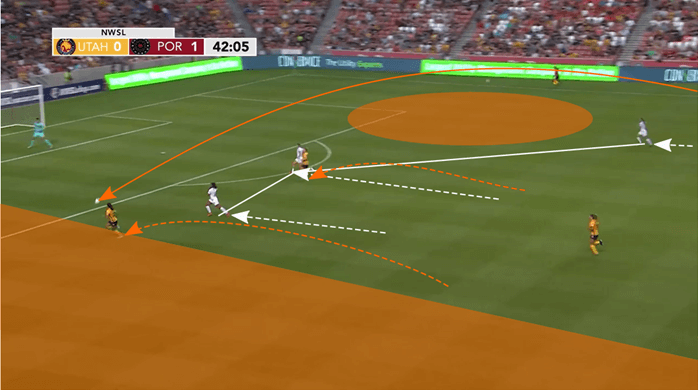
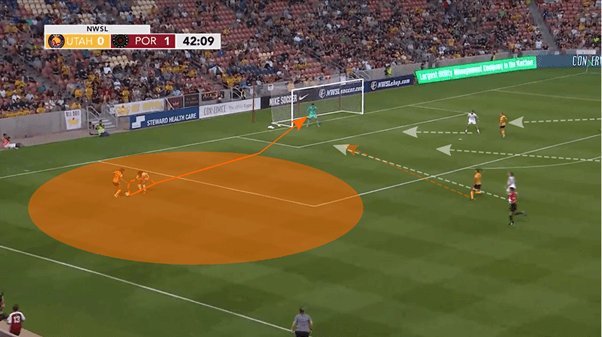
By playing on Elizabeth Ball’s shoulder, sticking out wide but in a more advanced position than perhaps would have been expected, Press was able to ask questions of Portland’s backline: do they follow her out and create a rupture in the middle? Do they withdraw Carpenter and lose an attacker? Or do they let her have her fun out wide? Time and again, Portland chose the latter.
With acres of space, Press could open her body and with no one covering her, Ball was unsure whether to show her opponent towards the byline or inside. She took a comical square-on body position, and Press delivered the punchline by poking it through her legs, rounding her, and finishing at the near post.
A special mention should go to Rodriguez who’s run in front of the defender was designed to distract the defender from closing down Press’ space. This gave the attacker enough time to round Ball and finish.
Whilst the Royals used the 4-2-3-1 formation with Press nominally on the left-wing, in reality, this formation took on many different incarnations. In its most orthodox sense, Press operated as a left-winger but with much more license than Jónsdóttir was afforded.
Rather, Jónsdóttir was integral to the build-up and came more inside to bolster the middle, Press was allowed to push further forwards and act as a wide striker. This is seen in the below game heat maps:
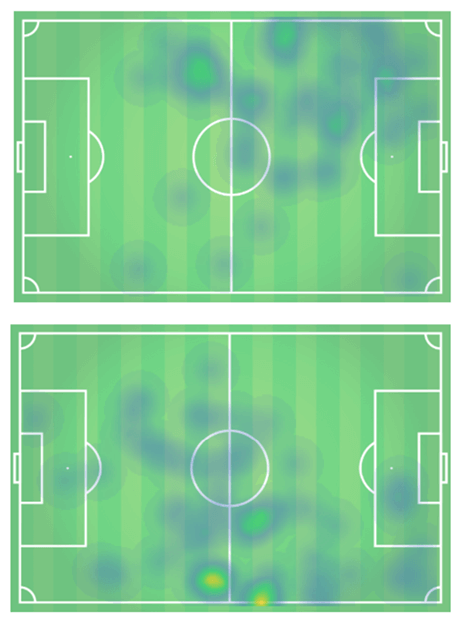
As we can see, whilst Jónsdóttir’s positioning was more concentrated and deeper, Press’ was less focused, higher and less central. This shows us that Press tended to take more attacking positions but had a free-reign, acting almost as a wide forward. Utah were lopsided but this helped their progressive tendencies flourish. They made 87 progressive passes, 10.53 more than their season average and 14 smart passes, 5.82 more than usual.
Horan turning up the heat
Contrary to the enthusiastic commentary team’s ramblings, the game itself was not a classic. It was bitty. It was exciting, it was lively and it was delicious to watch but it was certainly not the best advert for exciting play in a purist’s sense. It was a surprise-steel-chair-to-the-back-of-the-head excitement over the joy technical display of wrestling grapples.
In attack, particularly within one another’s final third, team shapes almost disintegrated. The proof of which was in the pudding: four exceptionally well-taken goals but really, none that were the result of an excellent series of play.
Some may be resistant in crediting the significance of set pieces to tactical analysis but the presence of World Cup returnee Lindsay Horan to the Portland Thorns makes this a significant area for analysis. Utah won seven fouls off of their opponents and looked keen to use these in any way possible. Horan scored what was set to be a winning goal for the Thorns deep in the game, picking up a knock in the process.
Whilst the Thorns frontline was active in trying to disrupt the Royals’ backline with movement deeper into the spaces in midfield, Horan proved to be one of their most dominant players. In attack, she was the focal point of their set-piece plays, relying on her strong physical presence to bully her markers. Two examples are seen below:
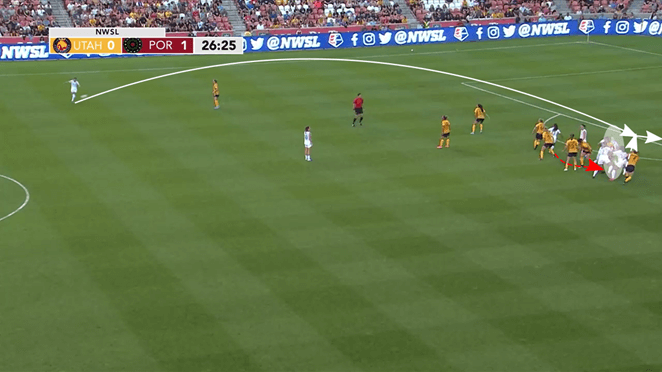
Whilst the first example was offside which he almost converted, live footage showed her shake off two of her fierce markers. She broke into space, curving her run behind to force her opponents to stumble into one another.
Portland looked to curve the ball inside, encouraging Horan to make this movement and to encourage the Utah players to have to meet the ball. Whilst this could make a potential defensive header easier, Horan’s lurking behind left them with a perpetual sense of unease.
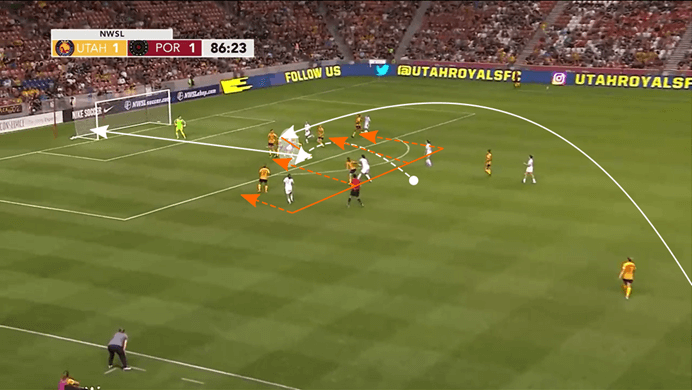
This second example, Horan’s goal, followed a very similar style. Again, Utah believed a higher line would try and catch stray movements offside. This time, however, Horan dropped a few yards deeper and added an even more audacious curve to her run.
Whilst this took her further away from the ball, she could attack it with more force. This led to a mistake in clearing the ball, allowing it to drop to her feet which she despatched with promptness into the corner, perhaps courtesy of a deflection.
Just in terms of the balance she gave her team as well, playing in midfield alongside Gabby Seiler, Horan’s obvious defensive strengths ensured that she could guard this area of the pitch solo. Admittedly, in the attack, the diamond Portland could play in the middle looked much more threatening than the limp lateral-two seen against Orlando Pride last week.
Through sitting deeper, Horan could pull strings in midfield. Although her passing percentage success was down to 79%, she increased her passes into the final third, into the box, in forwards in general, and reduced her backwards passing in general. A slight drop in accuracy (only 2%), is expected. Her importance in the middle of Portland’s passing network is seen in the graphic below.
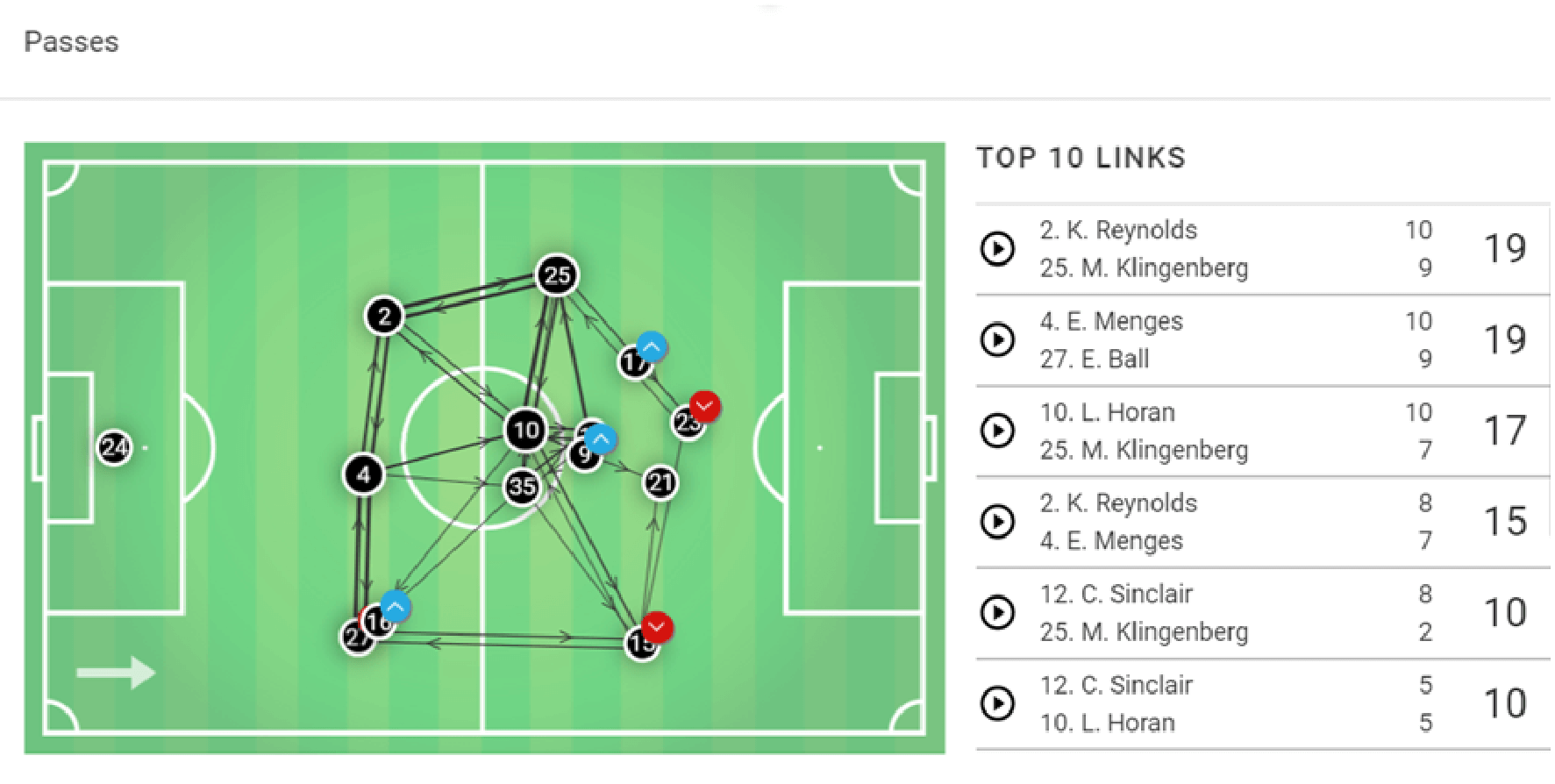
Furthermore, by having Horan as a capable defensive-shield on her own, this allowed Seiler to advance and provide more definitive presence further forwards to try and help maintain a press. Ultimately, Portland never really utilised the potential of this but it’s something Parsons must look to use as his midfield gem has returned to the core of his team.
Decent pressing but a little inconsistent?
Many have written about the importance of pressing, counter-pressing, counter-counter-pressing, and counter-counter-counter-pressing as of 2019. With the number of refinements which this type of defending (or as some consider it, an attacking art form), has taken, it felt odd that in this game neither side could consistently accomplish a well-defined press.
Perhaps the most interesting refinement of the manoeuvre came later in the game. Portland Thorns’ players took an almost open-body shape to try and force their opponents down the line but into a more central position.
It was then in this more central position where the Portland attack would press hard and try to force an error, make a tackle, or just plant their studs on their opponents. Late in the game, we saw an example of this below.
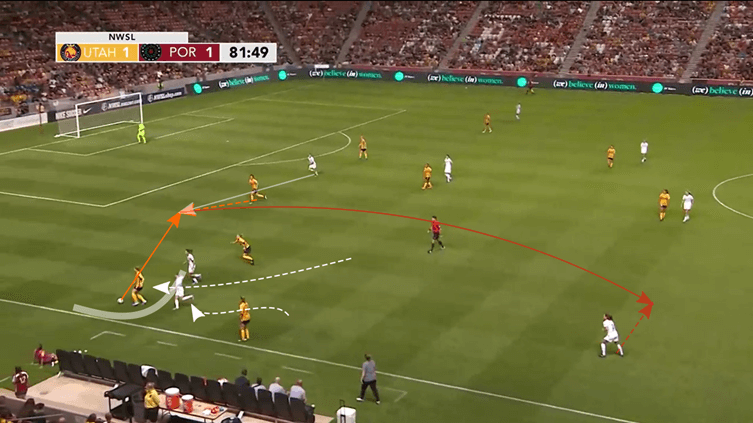
Through curving their tracking run on the defender, Portland encouraged the Utah Royals defender to turn inside. Whilst not quite a hospitable ball, there was a lack of awareness of the target and her marker.
Although the ball was cleared and a freekick was won due to the lateness of the challenge, this was fortunate. Portland wanted the clearance to find their defender who would then turn inside and look to exploit the space and overload the centre whilst Utah’s defence were preoccupied on their right-side.
For Utah, however, we also some very good examples of the press but they were quite inconsistent at rolling this out. All the same, their exceptionally low PPDA of 7.74 (passes allowed per defensive action), which is commonly used to measure the quality of a teams press, trumped Portland’s respectable 10.34. The issue wasn’t whether Harvey’s side could press, it was that it was unevenly applied across the 90 minutes. A very good example of it is shown below, however:
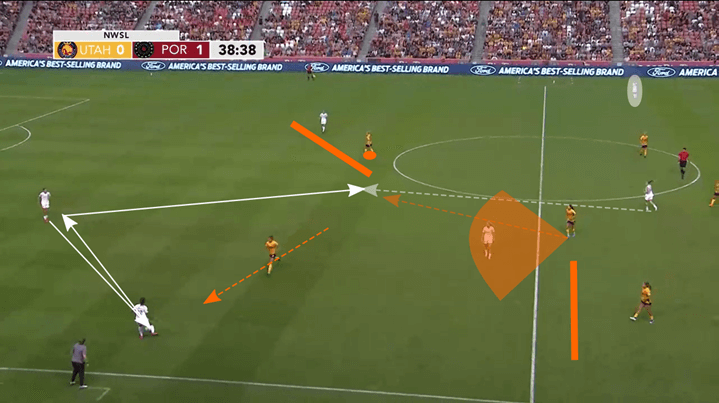
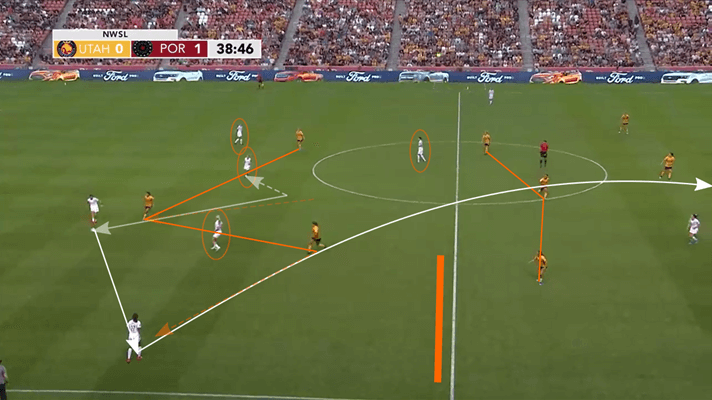
Portland like to try and open play by bumping short passes off one another, although with only 333 passes attempted across the game, they didn’t really carry this into the fixture. However, we can see that Utah allow a runner from midfield to claim the ball from the backline. What is notable though, is how well they then reform to shut out the rest of their play.
As Press is enabled from this runner from midfield, she chases the ball down, this triggers her teammates in the front line to also move closer to their own opposites. The angle of Press’ charge cuts off the angle to two passing options on its own. Also, the midfield triumvirate are narrow enough to force a blockade wide but also flexible enough to cover the channel. The long ball down the line becomes Ball’s only option. This is flagged for offside and Utah’s mid-pitch-pressing has proven to be successful in this instance.
The goal for Harvey must be to build on this tactic. Her side are well-drilled and with such an impressive ability to press their opponents combining with a fast and fluid forwards line, this could lead to an exponential glut of goals.
Conclusion
This game had the feel of an exhibition match: fans flocking to the stadium in anticipation of seeing their returning World Cup heroes no matter their kit colour; individual bits of brilliance; and an almost false-hype from the American colour commentary team. Make no mistake, this was an interesting game with some intriguing avenues for tactical analysis. Yet, it would hardly earn a spot on the bookshelf in the Great Library of football tactics.
We could learn from the game, however. It further showed that despite picking up some decent results of late, Parsons’ 3-4-3 is horrendous at transitioning into a defensive shape. It also showed how the Royals have potential to improve. This is crucial, considering that their last victory came over a month ago, and even then against a pre-resurgent Sky Blue. Perhaps most importantly, however, we learned how fundamental individual star power is to this league sustaining itself.

If you love tactical analysis, then you’ll love the digital magazines from totalfootballanalysis.com – a guaranteed 100+ pages of pure tactical analysis covering topics from the Premier League, Serie A, La Liga, Bundesliga and many, many more. Buy your copy of the July issue for just ₤4.99 here, or even better sign up for a ₤50 annual membership (12 monthly issues plus the annual review) right here.

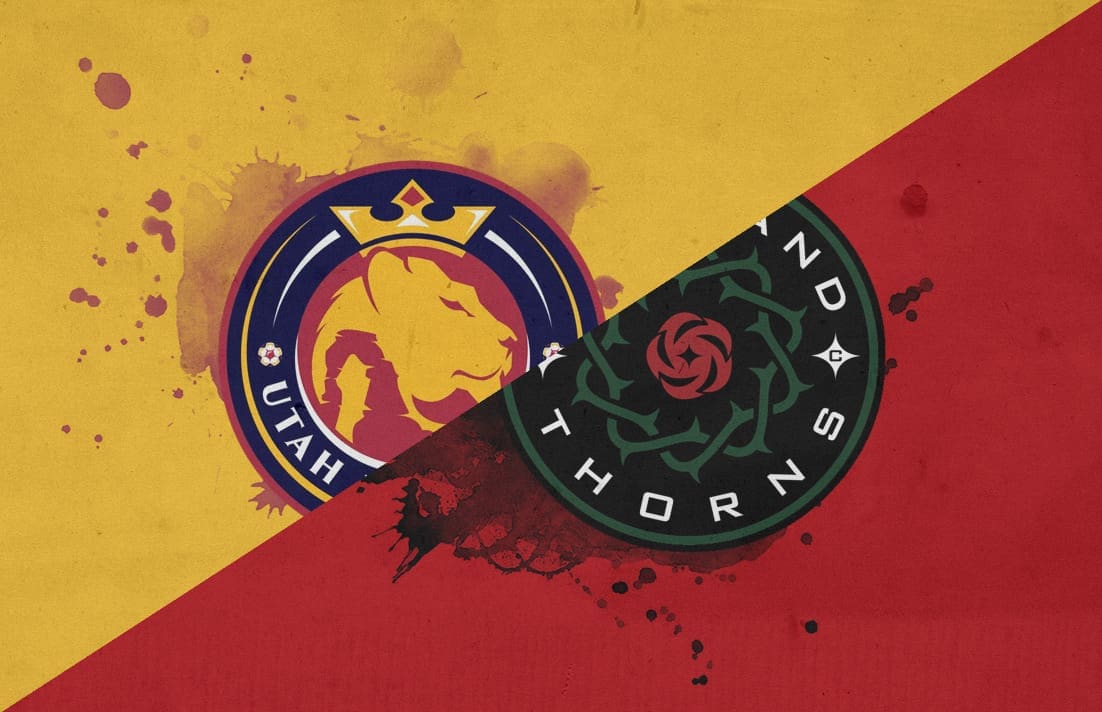



Comments